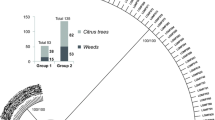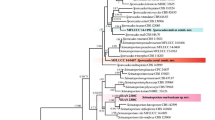Abstract
Isolates of the Colletotrichum gloeosporioides species complex from grape ripe rot in Nagano Prefecture, Japan in 2016–2017 were identified and their morphology, virulence, and fungicide sensitivity clarified. Based on phylogenetic analysis of the ApMat locus, 80 isolates were identified as belonging to four species, C. perseae (17.5%), C. viniferum (8.8%), C. fructicola (7.5%), and C. gloeosporioides sensu stricto (2.5%) and another species designated Clade V (63.8%). Clade V was the most important pathogen in Nagano Prefecture because of its predominance and high virulence. Colletotrichum perseae and C. fructicola both had a sexual stage and were often found to be resistance to QoI fungicides; they were dominant in the northern region of Nagano Prefecture in 2016. These four species and Clade V can be distinguished by the growth rate of their colonies and morphology of their conidia and ascospores. The results of this study suggest that identification of dominant species in each field is necessary to determine the most suitable fungicide application for disease control.




Similar content being viewed by others
References
Anonymous (2016) Annual report of plant protection. Nagano Pref. Plant Protection Center, Suzaka, Nagano, Japan (in Japanese)
Anonymous (2017) Annual report of plant protection. Nagano Pref. Plant Protection Center, Suzaka, Nagano, Japan (in Japanese)
Anonymous (2019) Past weather data download. Japan Meteorological Agency, Tokyo. https://www.data.jma.go.jp/gmd/risk/obsdl/index.php. Accessed 1 Mar 2019
Felsenstein J (1985) Confidence limits on phylogenies: an approach using the bootstrap. Evolution 39:783–791
Inada M, Ishii H, Chung W, Yamada T, Yamaguchi J, Furuta A (2008) Occurrence of strobilurin resistant strains of Colletotrichum gloeosporioides (Glomerella cingulata), the causal fungus of strawberry anthracnose (in Japanese with English summary). Jpn J Phytopathol 74:114–117
Ishii H (2009) Corynespora cassiicola. In: Manual of sensitivity to fungicides of plant pathogens II. Japan Plant Protection Association, Tokyo, pp 69–71 (in Japanese)
Ishii H, Fraaije BA, Sugiyama T, Noguchi K, Nishimura K, Takeda T, Amano T, Hollomon DW (2001) Occurrence and molecular characterization of strobilurin resistance in cucumber powdery mildew and downy mildew. Phytopathology 91:1166–1171
Jayawardena RS, Hyde KD, Damm U, Cai L, Liu M, Li XH, Zhang W, Zhao WS, Yan JY (2016) Notes on currently accepted species of Colletotrichum. Mycosphere 7:1192–1260
Kimura M (1980) A simple method for estimating evolutionary rate of base substitutions through comparative studies of nucleotide sequences. J Mol Evol 16:111–120
Lei Y, Tang XB, Jayawardena RS, Yan JY, Wang XD, Liu M, Chen T, Liu XM, Wang JC, Chen QX (2016) Identification and characterization of Colletotrichum species causing grape ripe rot in southern China. Mycosphere 7:1177–1191
Liu F, Weir BS, Damm U, Crous PW, Wang Y, Liu B, Wang M, Zhang M, Cai L (2015) Unravelling Colletotrichum species associated with Camellia: employing ApMat and GS loci to resolve species in the C. gloeosporioides complex. Persoonia 35:63–86
Misawa T, Kurose D, Sato T (2017) Occurrence of grape ripe rot caused by Colletotrichum viniferum new to Japan and C siamense (abstract in Japanese). Jpn J Phytopahol 83:71
Peng L, Sun T, Yang T, Cai L, Hyde KD, Bahkali AH, Liu Z (2013) Colletotrichum species on grape in Guizhou and Yunnan provinces, China. Mycoscience 54:29–41
Saitou N, Nei M (1987) The neighbor-joining method: a new method for reconstructing phylogenetic trees. Mol Biol Evol 4:406–425
Sato T (1997) Characters and identification of a plurivorous anthracnose fungus, Colletotrichum acutatum (in Japanese with English summary). Proc Assoc Pl Protec Shikoku 32:1–19
Sato T, Moriwaki J, Aoki T, Nemoto H (2017) Update of pathogen names of several anthracnose based on molecular re-identification of NIAS Genebank strains belonging to the Colletotrichum gloeosporioides species complex (abstract in Japanese). Jpn J Phytopahol 83:43–44
Sharma G, Kumar N, Weir BS, Hyde K, Shenoy BS (2013) The ApMat marker can resolve Colletotrichum species: a case study with Mangifera indica. Fungal Divers 61:117–138
Sharma G, Pinnaka AK, Shenoy BD (2015) Resolving the Colletotrichum siamense species complex using ApMat marker. Fungal Divers 71:247–264
Sharma G, Maymon M, Freeman S (2017) Epidemiology, pathology and identification of Colletotrichum including a novel species associated with avocado (Persea americana) anthracnose in Israel. Sci Rep 7:15839
Silva D, Talhinhas P, Várzea P, Cai L, Paulo O, Batista D (2012) Application of the Apn2/MAT locus to improve the systematics of the Colletotrichum gloeosporioides complex: an example from coffee (Coffea spp.) hosts. Mycologia 104:396–409
Tamura T, Stecher G, Peterson D, Filipski A, Kumar S (2013) MEGA6: molecular evolutionary genetics analysis version 6.0. Mol Biol Evol 30:2725–2729
Thompson J, Higgins D, Gibson T (1994) CLUSTAL W: improving the sensitivity of progressive multiple sequence alignment through sequence weighting, position-specific gap penalties and weight matrix choice. Nucleic Acids Res 22:4673–4680
Udo Y (2015) Kasakake, Fukurokake (in Japanese). In: Nougyou gijutsu taikei, Kajuhen, 2 Budou. Noubunkyo, Tokyo, pp "gi" 69–70
Weir BS, Johnston PR, Damm U (2012) The Colletotrichum gloeosporioides species complex. Stud Mycol 73:115–180
Yan JY, Jayawardena RS, Goonasekara ID, Wang Y, Zhang W, Liu M, Huang JB, Wang ZY, Shang JJ, Peng YL, Bahkali A, Hyde KD, Li XH (2015) Diverse species of Colletotrichum associated with grapevine anthracnose in China. Fungal Divers 71:233–246
Yokosawa S, Sato T, Kondo K (2015) Identification of the Colletotrichum gloeosporioides species complex members isolated from apple and grape in Nagano (abstract in Japanese). Jpn J Phytopathol 81:206
Yokosawa S, Eguchi N, Kondo K, Sato T (2017) Phylogenetic relationship and fungicide sensitivity of members of the Colletotrichum gloeosporioides species complex from apple. J Gen Plant Pathol 83:291–298
Acknowledgements
We thank the Nagano Prefecture Agricultural Extension Center for help with collecting material; Ms. Akiko Yokota, Ms. Mariko Katsuyama, and Ms. Asami Nakamata for technical assistance. We also sincerely thank Dr. Yoshihiko Adachi and Dr. Atsuko Sasaki, Institute of Fruit Tree and Tea Science, NARO, Japan for their helpful suggestions.
Author information
Authors and Affiliations
Corresponding author
Ethics declarations
Conflict of interest
The authors declare that they have no conflict of interest.
Human and animal rights
This article does not contain any studies with human participants or animals performed by any of the authors.
Additional information
Publisher's Note
Springer Nature remains neutral with regard to jurisdictional claims in published maps and institutional affiliations.
Electronic supplementary material
Below is the link to the electronic supplementary material.
Rights and permissions
About this article
Cite this article
Yokosawa, S., Eguchi, N. & Sato, T. Characterization of the Colletotrichum gloeosporioides species complex causing grape ripe rot in Nagano Prefecture, Japan. J Gen Plant Pathol 86, 163–172 (2020). https://doi.org/10.1007/s10327-020-00907-5
Received:
Accepted:
Published:
Issue Date:
DOI: https://doi.org/10.1007/s10327-020-00907-5




